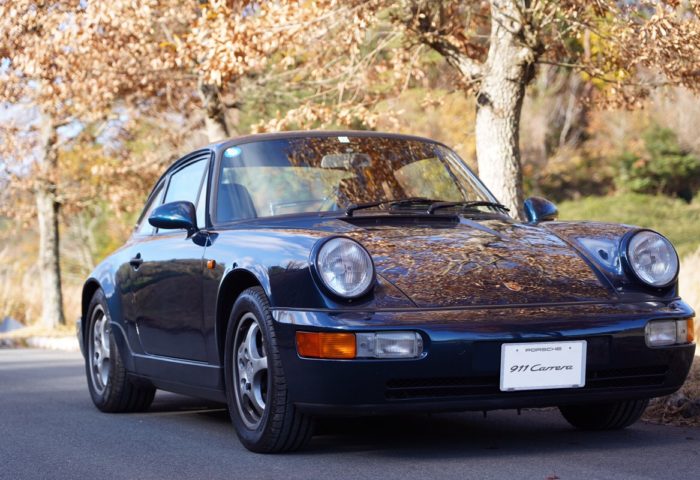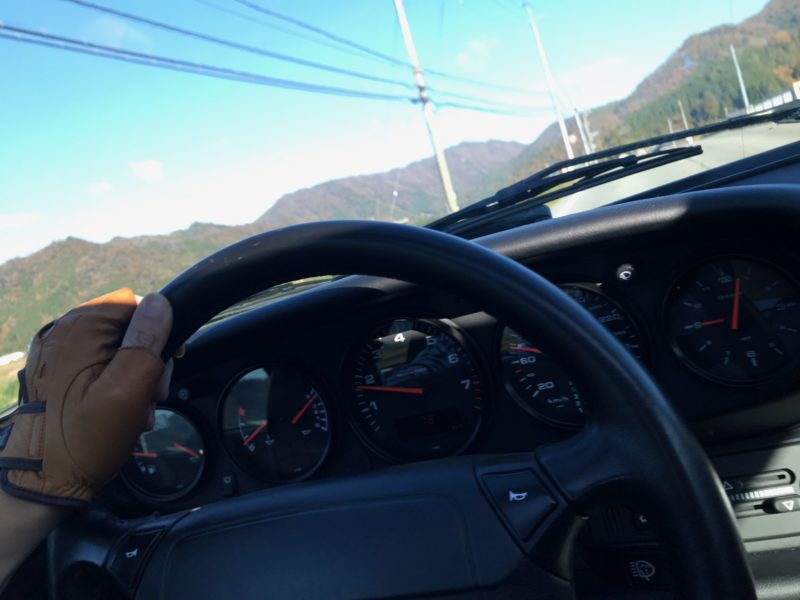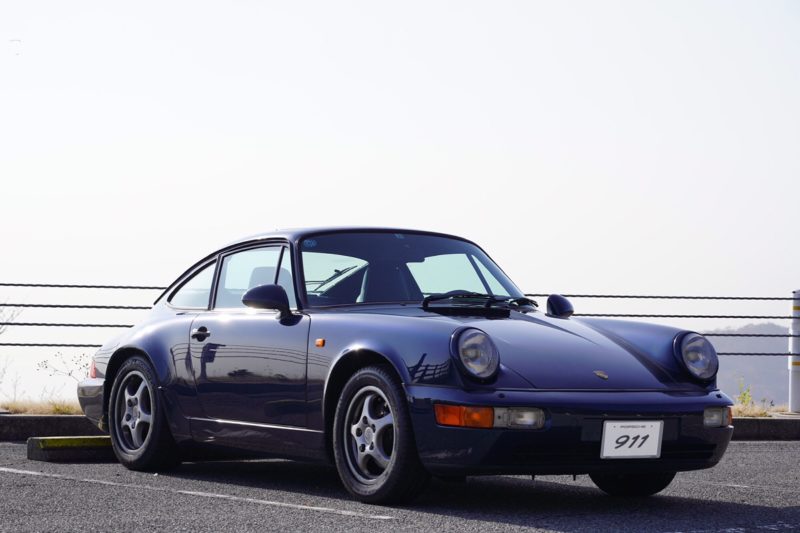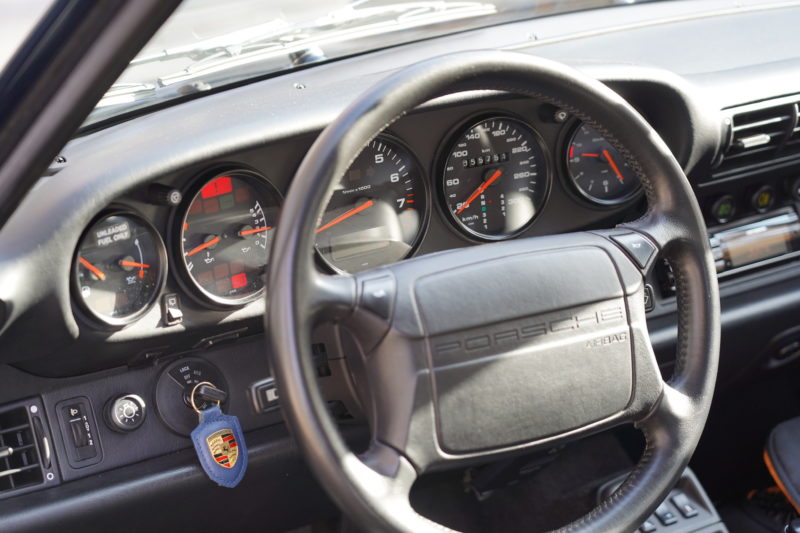I Asked My Husband, Who Drives the Porsche 911 (964C2) Almost Every Day, What Makes It So Great [Part 1]
公開日:2018.12.06

Is the 911 Really That Good?
It’s almost been a month since the Porsche 911 (964C2) was delivered on November 9th. Time flies… Since then, my husband has been driving this 911 almost every day and apparently has already covered over 1,000 km. He really loves it! (laughs) By the way, here’s my husband’s first impression of the car, but after driving it for a while, he said, “My feelings have changed again. The more I drive it, the better it feels.” So I asked him what exactly makes it so good. This time, I’d like to share his thoughts on the “ride comfort” and the “challenges and charms of the RR layout.”

Ride Comfort
Regarding the ride comfort of the 911 (964C2), my husband says:
When driving slowly and normally, you really feel the solid, robust rigidity and a clear sense of contact from all four wheels. On rough roads, especially from the rear, you can directly hear the “thump! thump!” sound, and the harshness when crossing joints on Japanese expressways seems to say “I don’t care!” But strangely, the sound and the intensity of the impact don’t really match up.
…Um… what exactly is “harshness” (-_-)…?
*Harshness (Noise, Vibration, Harshness) is one of the standards used to measure automotive comfort. The acronym NVH is often used, and in automotive design and magazines, it’s sometimes called “otoshin” (sound and vibration).
I see. I’d never heard the word “harshness” before. Continuing, my husband said:
When I hear the “thump!” sound, I instinctively brace for a big impact, but it’s not that strong. The shaking is less than you’d expect from the noise. The ride is relatively flat, and there’s little vertical movement of the viewpoint. This is probably due more to the high body rigidity than just the softness and cushioning of the seat surface.
Indeed. I also felt the body’s rigidity was by far the highest among all the Porsches I’ve driven. It’s often described as “like a safe,” and it really feels like you’re riding inside a safe.

That said, compared to modern Boxsters, the ride is clearly firmer, and it feels like NVH (noise, vibration, harshness) wasn’t a major design focus. However, when sitting in the front seat, it doesn’t feel “uncomfortable,” and personally, the ride comfort is within an acceptable range. (He says the Boxster feels very soft these days.)
On the other hand, the rear seats have thin cushions and are cramped, so if you put children in the back, they might complain. But thankfully, our daughters seem to like the tight feeling back there.
That said, I’d add that while our daughters like it for rides of 5 to 10 minutes, anything over an hour is tough. Recently, I drove the 911 (964C2) with my daughters in the back for about an hour and a half, and after about 30 minutes, my eldest started saying “My back hurts.” We tried putting jackets down to help, but then the girls started crying and fussing, so I ended up moving to the back seat myself.
…After that, the three ladies in the car (me and my two daughters) were grumpy the whole time (lol).
The Challenges and Charms of the RR Layout
This 911 (964C2) shows a completely different character when you press the accelerator a bit and take a corner.
The body roll feels less than the Boxster GTS in Sport Plus mode. Of course, corners feel stable and I don’t feel uneasy. However, the way it corners differs between when you brake or lift off the accelerator properly to shift weight, and when you just coast through. When you apply the correct weight transfer, it feels like the rear pivots the car around, which is a fresh sensation you can’t get with a Boxster. I really feel, “Ah, so this is what RR is all about.” But if you just coast through corners, it doesn’t quite inspire that “wow!” feeling. Well, it still corners better than most normal cars.
Also, I’d heard that lifting off the accelerator mid-corner causes serious oversteer, but when driving on regular winding roads at sensible speeds, it’s not dangerous at all. The behavior does change a bit, but I think there’s a safe margin even for ordinary drivers. Still, you should be careful in winter when the road and tires are cold.
I haven’t yet mastered the feeling of applying the correct weight transfer, so I haven’t experienced the “joy of cornering” yet. Right now, the challenge of RR feels bigger than the fun, but I want to be able to corner smoothly soon.

That said, my husband hasn’t reached the level where he can consistently corner correctly either…
I guess being able to do this all the time is what it means to be a true “911 driver.” I’m getting there, but it’s trial and error every time, and that’s what makes it fun when it finally works.
Also, when accelerating uphill on a somewhat steep slope and turning a corner, he sometimes feels the front lose load briefly, causing strong understeer. Conversely, downhill driving is easier. With a mid-engine Boxster, uphill and downhill don’t differ much and you can corner with a consistent radius, but this is another unique aspect of the RR layout.

Regarding the impression on the highway:
I’d often heard from 911 drivers that “when you push it, the front feels like it’s floating,” so I was curious. But after driving it myself, I didn’t feel it was that unstable. Sure, the front feels a bit unsettled during acceleration, but it’s strange how you still feel in control of the car. In that sense, it’s completely different from the instability you get when pushing a Japanese car hard on the highway.
Indeed, while acceleration feels a bit unsettled, it’s not unstable, so there was no scary feeling like when driving a Japanese car fast on the highway.
When pushing it a bit on the highway, the steering can be a little affected by crosswinds and ruts, but personally, it’s totally acceptable. The aerodynamic and structural instability isn’t as bad as I’d heard. Of course, compared to modern Porsches it’s inferior, so if you’re driving over 200 km/h on the Autobahn, it might be a different story. But at speeds like running in the passing lane on the Shin-Tomei Expressway, it’s not much of an issue.
That’s what he said.
I see… So next time, I’d like to cover “the air-cooled engine” and a “final summary.” By the way, my husband was also very passionate about the Tiptronic transmission, so I want to introduce that properly in a separate article.
このブログが気に入ったらフォローしてね!


Comment ( 0 )
Trackbacks are closed.
No comments yet.